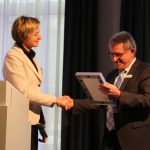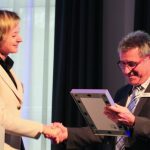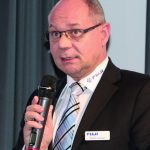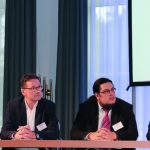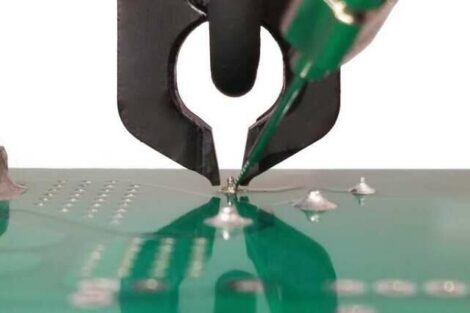With a 2-day celebration in Wiesbaden, Germany, Fuji Machine Europe commemorated their 25-year mark with 250 clients and partners at the Fuji Open House. With a 2-day program, interesting presentations took place regarding accomplishments, future company plans, a technical tour, and a podium discussion about the developments of Industry 4.0.
Since the start of the company in 1991, Fuji has developed into a full-line supplier. Starting with board handling and adhesive dispensers, to now including paste printers, the company ensures the needs of all customers are met.
Klaus Gross
The Spirit of 25 Years of Innovation
As the Managing Director since 2012, Klaus Gross gave an overview of the company’s history starting with November 1991 when it was founded by Hiroo Itoh. In June 1992, the sales and service operation in Mainz-Kastel started with ten employees and six departments in a 500 m² space.
They have continued to grow since then, even through two market crises, one in 2001 and the other from 2003 to 2009, and are now in a 2,000 m² space with 70 motivated employees. They are also planning to build a new office building in the business area of Staudenäcker in Kelsterbach starting in March 2018. With this investment, enough room and space will be available for further growth. The company first began with focusing on the telecommunication field; however, they are now also pushing towards the automotive sector, including customers that are well-known manufacturers. This growing market focuses on industrial and consumer electronics. The goal for the future is not only to increase the market share with new customers and future projects, but also to increase customer satisfaction and their own efficiency by improving internal communication.
Keynote: Lutz Wagner, Executive coaching
Making decisions in stressful situations
After nearly 20 years as a federal league judge, in 2010 the speaker decided to change career directions to become a coordinator for the referee training at DFB and a coach for the German National Referee League. With this drastic change, he experienced firsthand how to deal with certain situations depending on the role one plays. For example, a manager should always be vigilant, analytical, supportive, accompanying, and decisive. On the other hand, a project manager should be more versatile, informative, and knowledgeable. Further training on behavior and conduct is crucial when making decisions in critical situations. Additionally, the most important factor is to make the actual decision, whether it is right or wrong comes second. However, before a decision can be made, preparation is necessary which takes place in two phases. The first phase is to gather all important information to be able to plan accordingly. The second phase consists of believing in oneself and trusting that the decision made is the most suitable. Afterwards, it is highly recommended to reflect and analyze the conclusion. After all, perfection is hard to attain and one should always strive to learn from mistakes that occurred. This presentation closed with three final points: good decision makers are automatically identified, how well a decision maker handles a controversial situation is important, and last but not least, to minimize errors when making a critical decision one should always act instead of react to a situation.
Stefan Janssen
Project Smart-Fab: Siemens Berlin
The presentations started with an overview of both Backend and Automation themes, which is precisely the aim for the concept of the machine for the Smart-Fab project. The machine is configured based on what is needed and required, as each component of the system is independent from each other. The unit interacts with the machine based on the process performance. The speaker further explained the different possibilities of the systems adaptations. The Smart-Fab supports various components, including radial and axial belts, trays, sticks, and bulk material conveyors. The specific part that is needed will be selected based on the shape of the component, which will then automatically be replaced in the machine. The Smart-Fab is a solution for automation and production concepts of Industry 4.0 and the Internet of Things. Since September 2016, in the collaboration with the Measuring Equipment Berlin of Siemens AG, the Smart-Fab machine can now show its true capabilities and has replaced the manual assembly printed circuit boards in the Backend.
Hartmut Eger
Presentation & World Premier AimexIII
To meet the growing demands of high-mix, variable mix, as well as, flexible volume production, the AimexIII and its sister assembly platform AimexIIIc were developed. The main difference between both systems is the size. With its compact design and reduced length, the AimexIIIc provides space saving in the production line. The AimexIII offers up to 130 feeder slots in the front and back. The DynaHead, with its revolving heads and grippers, can make the assembly of any sized components, from small to large. With its single-track configuration, the AimexIII can work with circuit boards up to 710 mm x 924 mm. With its double-track configuration, two different products can be equipped at the same time, which increases the capacity of production. Including the puffer function will increase production even more. The functions on the machine can be changed or edited directly on a 12-inch touchscreen. Not only will this speed up the process of finding the best solutions to errors that may occur, but also the user will be able to react as quickly as possible. The LCR Check is used for measuring and verifying all characteristics of each component to guarantee the quality of each, even when there are a variety of different volumes.
Florian Ritter, Asys Group
Asys Smart Factory with Pulse
Smart Factory is an essential part of Industry 4.0. This concept breaks down complicated processes, such as, marking, printing, mounting, and de-paneling. This also brings a connection between the individual isolated solutions and the autonomous transport robots. Software is of course an important component to this trend, which is gaining more and more recognition. With Pulse, there is a variety of devices, plating connections, and software solutions that are offered, which significantly simplifies day-to-day work in the production environment. More specifically, the Pulseone software is designed for cross-line applications. By using the app, new features and upgrades can be downloaded at any time directly to the software. Along with this, robots supply the production line automatically with material, creating a self-organized logistics for materials. This can also be integrated to be used in manual workstations. By using robots or Smartwatches, complex production processes are now less complicated, supporting the user in all aspects, making monotonous work no longer an issue. This will be possible only if a new mindset takes place and we have the courage to believe in the future of the industry and all that it can bring.
Ulf Oestermann, IZM Fraunhofer Berlin
Industry 4.0 – Rebellion of Machines
What would happen if there was a rebellion of machines, and an assembly machine automatically presses the dash button? The speaker answered the questions of where such a development came from, what is happening with it now, and where will it go in the future. It all began with the first industrial revolution starting at the end of the 18th century, involving mechanical production plants operated with the help of water and steam power. Today, we are in the fourth industrial revolution of cyber-physical systems that is mainly driven by the complexity of manufactured products, as well as, the requirements and obligations of documentation. It can also be said that Industry 4.0 is highly dependent on the subject or perspective. Although there are many different support measures, ever since politicians have declared this an important subject, the efforts of individual companies are driven by costs. There are many advantages with this new trend, including minimizing downtime, as well as, optimizing cycle time and expanding the areas of component preparation and automatic storage. The future of this revolution looks very promising. The speaker explained that it will promote the development of protocols and sensor interfaces, the integration of vertical and horizontal levels in production, and the implementation of Multi-transmission Bases. All sensors and software interfaces are to be accessible across the entire system. There will also be a stronger focus on usability of all programs and interfaces.
Jonas Ernst
Future of Smart Factory & IoT
This presentation gave a great overview of what the future holds for FUJI and their systems. Building off the Nexim Machine, the existing software will be redesigned to be in the direction of Industry 4.0. The first part of this project, the focus plan, concentrates on program creation, optimization, simulation, setup changes, and flexible production scheduling across multiple production lines and machines. The second part of this project, the Do Plan, covers the preparation documents, support of material exchange, as well as, providing and tracking supplies for all operators. The last part for this project, the See Plan, focuses on monitoring all production lines in real time. No matter the location, the web based overview of production line utilization, production analysis, and traceability, will give the user more control. With this, it will also be easy to create new components and programs, as well as, use the optimization tools. Incorporating this project with MES-Systems, the luminance quality products, such as LEDs, and the control of moisture sensitive level components will be a child’s play. In addition, it will also be possible to integrate storage systems. The clear and easy-to-use interface will intuitively guide all users throughout the program. The data that is monitoring one machine or even an entire production line, even when machines are in different locations, will be collected in real-time. This will automatically optimize utilization and give an immediate response in the event of any faults or changes.
Dr. Werner Laub, Staufen AG & Mr. Heinz Floren, Insta Elektro GmbH
The Path to Added Value Excellence
The two speakers presented the journey the company, Insta, took towards added value excellence with the help of Staufen AG. With this new collaboration, along with Insta recognizing in 2014 that a change needed to take place to achieve the goals set in SMT production, a partnership was established to promote best practice solutions. At the time, the OEE performance of three production lines was just at 36 %, making the processing time about 10 days. Due to this, a comprehensive project was created to restore competitiveness in the SMT production, through creative approaches and by following the lean principles. By using these 4 phases: preparation, analysis, concept, and implementation, the project aimed to improve the process, logistic, and leadership areas. With this integrated approach, the Insta SMT manufacturing greatly improved by increasing the OEE performance to 65 % and cutting down the processing time to only 4 days. It also reduced personnel costs by 40 % and greatly reduced the set up time by almost 83 %.By creating these conditions for end-to-end-pull, the high demand created an increase in post-production for devices and modules.
Podium discussion
S.E.F.e.V- Industry 4.0
SEF Smart Electronic Factory e.V. and its associates are working together to find solutions for the popular trend, the fourth industrial revolution. Along with the moderator, Jonas Ernst, the Area Sales Manager of Fuji Machine, the following participants took part in the podium discussion: the CTO of iTac Software AG, Dieter Meuser, the Managing Director of Limtronik GmbH, Gerd Ohl, the SMD Manager of Limtronik GmbH, Marcel Pannu, and the Professor Dr. Gerrit Sames from the Technical University of Mittelhessen. The podium focused on the state of development, standards, and professionals within Industry 4.0. They also discussed how this revolution affected Germany compared to other countries. Although Germany is an exemplary character in the electronics industry, it still lags somewhat behind against the international competition. The panel also went into further discussion about which interface standards should be implemented to last the longest, which came to no concrete conclusion. On the subject of the cloud, the participants agreed that the transfer of data to the Cloud is secure, because data is well protected against attacks, making them safe. The end of the discussion focused on the fact that the main problem does not come from the lack of technology, but the main issue is converting these technologies into practical solutions. This is especially true for small to medium sized enterprises. (dj)
SMT Hybrid Packaging, Booth 4-131
Share:



